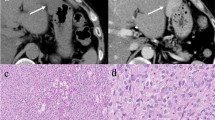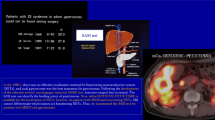Abstract
Purpose
Carcinoid and islet cell tumors are known to be highly vascular. There is no effective systemic therapy currently available for metastatic disease. We conducted a phase II trial to evaluate the efficacy of the anti-antiangiogenic agent thalidomide in metastatic neuroendocrine tumors.
Patients and methods
Eighteen patients with measurable, histologically proven metastatic carcinoid neuroendocrine carcinomas (well-differentiated, n = 13; moderately-differentiated, n = 5) were enrolled on this study. The majority of the patients had gastrointestinal primaries (small bowel, 8; pancreas, 5; colon, 1). All but one patient had hepatic metastases, and 12 patients (67%) had carcinoid syndrome. All patients had Eastern Cooperative Oncology Group performance status of zero or one. Eight patients (44%) had received previous hepatic artery chemoembolization and 11 (61%) had undergone surgical resection. Patients were started on oral thalidomide at a daily dose of 200 mg that was escalated to the target dose of 400 mg daily after 2 weeks. Tumor response was assessed at 12-week intervals using RECIST criteria. Planned treatment duration was 24 weeks unless unacceptable toxicity or disease progression was observed.
Results
No patient achieved a partial remission or a complete remission. Best response was stable disease (SD) in 11 of 16 response-evaluable patients (69%). Serum pancreastatin results did not correlate with clinical response. Grade 3 toxicities included dizziness with orthostatic hypotension (n = 5), sensory neuropathy (n = 2), fatigue (n = 2), hemorrhagic cystitis (n = 1), and deep venous thrombosis (n = 1). Frequent Grade 1–2 toxicities were: fatigue (n = 13), constipation (n = 13), dry mouth (n = 12), somnolence (n = 12), dizziness/syncope (n = 10), weight gain (n = 5), and peripheral neuropathy (n = 5).
Conclusions
Thalidomide was fairly well tolerated in patients with metastatic carcinoid/islet cell tumors, but failed to reveal any objective responses. The single stage design of the trial makes it difficult to determine whether observed SD in a subset of patients was attributable to the indolent nature of these tumors, or to beneficial effect of thalidomide.
Similar content being viewed by others
References
Baidas SM, Winer EP, Fleming GF et al (2000) Phase II evaluation of thalidomide in patients with metastatic breast cancer. J Clin Oncol 18:2710–2717
Bartlett JB, Dredge K, Dalgleish AG (2004) The evolution of thalidomide and its IMiD derivatives as anticancer agents. Nat Rev Cancer 4:314–322
Calhoun D, Toth-Fejel S, Cheek J et al (2003) Serum peptide profiles in patients with carcinoid tumors. Am J Surg 186:28–31
Creutzfeldt W, Bartsch HH, Jacubaschke U et al (1991) Treatment of gastrointestinal endocrine tumors with interferon-alpha and octeotide. Acta Oncol 30:529–535
Drake MJ, Robson W, Mehta P et al (2003) An open-label phase II study of low-dose thalidomide in androgen-independent prostate cancer. Br J Cancer 88:822–827
Drougas JG, Johnson CM, McKusick MA et al (1998) Hepatic artery chemoembolization for management of paients with advanced metastatic carcinoid tumors. Am J Surg 175:408–412
Eisen T, Boshoff C, Mark I et al (2000) Continuous low dose thalidomide: a phase II study in advanced melanoma, renal cell, ovarian and breast cancer. Br J Cancer 82:812–817
Escudier B, Lassau N, Couanet D et al (2002) Phase II trial of thalidomide in renal-cell carcinoma. Ann Oncol 13:1029–1035
Fehniger TA, Shah MH, Turner MJ et al (1999) Differential cytokine and chemokine gene expression by human NK cells following activation with IL-18 or IL-15 in combination with IL-12: implications for the innate immune response. J Immunol 162:4511–4520
Fife K, Howard MR, Gracie F et al (1998) Activity of thalidomide in AIDS-related Kaposi’s sarcoma and correlation with HHV8 titre. Int J STD AIDS 9:751–755
Fine HA, Figg WD, Jaeckle K et al (2000) Phase II trial of the antiangiogenic agent thalidomide in patients with recurrent high-grade gliomas. J Clin Oncol 18:708–715
Goebel SU, Serrano J, Yu Fang et al (1999) Prospective study of the value of serum chromogranin A or serum gastrin levels in the assessment of the presence, extent, or growth of gastrinomas. Cancer 85:1470–1483
Haslett PA, Corral LG, Albert M et al (1998) Thalidomide costimulates primary human T lymphocytes, preferentially inducing proliferation, cytokine production, and cytotoxic responses in the CD8+ subset. J Exp Med 187:1885–1892
Hwu WJ, Krown SE, Menell JH et al (2003) Phase II study of temozolomide plus thalidomide for the treatment of metastatic melanoma. J Clin Oncol 21:3351–3356
Kloppel G, Heitz P, Capella C et al (1996) Pathology and nomenclature of Human gastrointestinal neuroendocrine (carcinoid) tumors and related lesions. World J Surg 20:132–141
Kulke MH, Stuart K, Enzinger PC et al (2006) Phase II study of temozolomide and thalidomide in patients with metastatic neuroendocrine tumors. J Clin Oncol 24:401–406
Lin AY, Brophy N, Fisher GA et al (2005) Phase II study of thalidomide in patients with unresectable hepatocellular carcinoma. Cancer 103:119–125
Moertel CG, Lefkopoulo M, Lipsitz S et al (1992) Streptozocin–doxorubicin, streptozocin–fluorouracil or chlorozotocin in the treatment of advanced islet-cell carcinoma. N Engl J Med 326(8):519–523
Motzer RJ, Berg W, Ginsberg M et al (2002) Phase II trial of thalidomide for patients with advanced renal cell carcinoma. J Clin Oncol 20:302–306
Oliver SJ, Moreira A, Kaplan G (2000) Immune stimulation in scleroderma patients treated with thalidomide. Clin Immunol 97:109–120
Pujol JL, Breton JL, Gervais B et al (2006) A prospective randomized phase III, double-blind, placebo-controlled study of thalidomide in extended-disease (ED) SCLC patients after response to chemotherapy (CT): an intergroup study FNCKCC Cleo04-IFCT 00–01. Presented at the American Society of Clinical Oncology, abstract #7057
Rowland TL, McHugh SM, Deighton J et al (1998) Differential regulation by thalidomide and dexamethasone of cytokine expression in human peripheral blood mononuclear cells. Immunopharmacol 40:11–20
Rowland TL, McHugh SM, Deighton J et al (1999) Selective down-regulation of T cell- and non-T cell-derived tumour necrosis factor α by thalidomide: comparisons with dexamethasone. Immunol Lett 68:325–332
Raut CP, Kulke MH, Glickman JN et al (2006) Carcinoid tumors. Curr Probl Surg 43:383–450
Rajkumar SV, Witzig TE (2000) A review of angiogenesis and antiangiogenic therapy with thalidomide in multiple myelomas. Cancer Treat Rev 26:351–362
Rubin J, Ajani J, Schirmer W et al (1999) Octreotide acetate long-acting formulation versus open-label subcutaneous octreotide acetate in malignant carcinoid syndrome. J Clin Oncol 17:600–606
Tseng JE, Glisson BS, Khuri FR et al (2001) Phase II study of the antiangiogenesis agent thalidomide in recurrent or metastatic squamous cell carcinoma of the head and neck. Cancer 92:2364–2373
Acknowledgments
This work was supported by a grant from the Celgene Corporation, Summit, NJ.
Author information
Authors and Affiliations
Corresponding author
Rights and permissions
About this article
Cite this article
Varker, K.A., Campbell, J. & Shah, M.H. Phase II study of thalidomide in patients with metastatic carcinoid and islet cell tumors. Cancer Chemother Pharmacol 61, 661–668 (2008). https://doi.org/10.1007/s00280-007-0521-9
Received:
Accepted:
Published:
Issue Date:
DOI: https://doi.org/10.1007/s00280-007-0521-9




